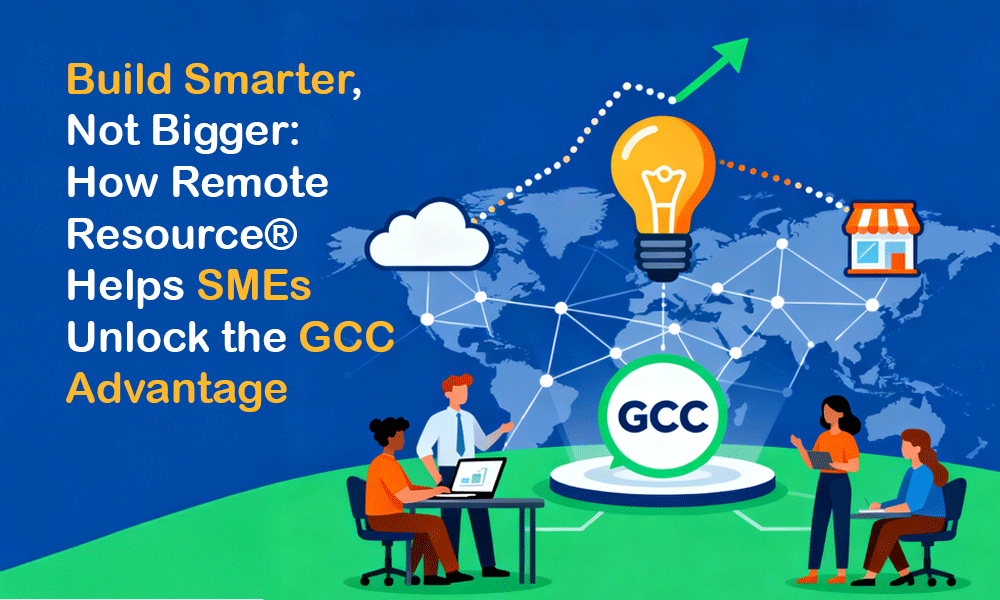Every year, the business world adds millions of new businesses. Every year, a young entrepreneur opens their small business in a garage or shack somewhere on this planet with dreams of winning big. And every year, hundreds of thousands of businesses close down—often, forever, in a bid to grow too fast, without having paid much thought to smart scaling.
Running a business successfully isn’t child’s play. It takes some serious amount of work, planning, and grit to launch a brand, keep it floating, and actually grow into something everyone notices after a while. Every big brand on the planet was once a fledgling, trying desperately to survive in a brutally tough world. And they all did one thing right: they scaled smart.
The GCC Story
If what you read above is something you could relate to, welcome to our primary reader base—current or would-be entrepreneurs looking to launch and grow their business into a titan. And you’d better know about global capability centers! The GCC story starts back in the 80s and 90s with a couple of US companies experimenting with what was then called outsourcing. They would send some of their boring, backend processes to offices in India and keep the spear’s tip for themselves. So, customer support went to India, bookkeeping went to India and the Philippines, IT support went to—once again—India. And so on. But something happened between then and the early 2000s that ushered in an era of change.
India adopted a more global stance in terms of economic policies. The West and the East decided to come closer. And backwater call centers made way for global capability centers—the second nerve center of global trade. By definition, a GCC is a captive unit within a larger organization, doing whatever work they have been assigned. In reality, GCCs are much bigger and more complex. They are often Indian companies in partnership with global conglomerates, acting as centers of innovation, spearheading breakthroughs in technology. But all that is for large businesses, right? Wrong! An increasingly large number of small and mid-sized businesses are waking up to the fact that they can leverage GCCs too. This rising trend is reflected in the rise of mid-market GCCs in India. The country boasts some 480 mid-market GCCs serving SMEs.
What’s in it for SMEs?

“GCCs are literal game-changers for SMEs.”
“No shit!”
Yeah, because GCCs enable SMEs to:
- Scale rapidly without directly employing costly manpower.
- Tap into a bottomless talent pool that has every kind of human resource imaginable.
- Explore new technologies and markets without betting the farm.
Imagine this for a second: a mid-sized SaaS company in Austin trying to roll out an AI-powered analytics tool. Now, hiring AI engineers locally is expensive, time-consuming, and high-risk. They know that. So they partner with a global capability center, say Remote Resource®. Now, they can instantly tap into inexpensive AI talent, prototype faster, and hit the market ahead of competitors.
What did our humble Austin-based company do right? They didn’t try to build big. They built smart. Speed, flexibility, and resilience are the three tenets of modern business that let SMEs build smart. GCCs ensure their partners never veer away from those tenets.
Remote Resource®: The GCC Democratizer
So far, we’ve only painted a rosy picture of GCCs. But setting up one from scratch is no joke. You need legal approvals, office space, recruitment teams, compliance frameworks, and tick a host of other boxes in order to build a global capability center from the ground up. But why go through so much trouble when you have Remote Resource® to partner with?
Instead of launching GCCs themselves, SMEs can simply make use of Remote Resource®’s staff augmentation model and enjoy the full benefits of a global capability center.
It works like this:
- You define the skills you need, say a data scientist, a mobile app developer, or a financial analyst.
- Remote Resource sources vetted professionals from its global talent pool.
- You choose your resource from the talent pool.
- These professionals work as your extended team, aligned with your goals, but without bringing along the hassles of permanent overheads. And yes, they cost far less than regional talent with similar work experience.
- You neither invest in office setups nor in costly infrastructure, all while leveraging the services of a team that’s at the forefront of global innovation.
That’s what we call setting up a GCC without racking your brain. In short, SMEs get the GCC muscle without the GCC headaches.
Why SME’s Can’t Afford to Miss This Opportunity
The truth is, fighting with giants and staying afloat isn’t easy! It’s super hard and SMEs have to face this harsh reality every day. Every hire, every dollar, every hour must deliver ROI. But the Remote Resource® GCC model is tailored for this kind of sport, if you will. How? Let’s see.
- Agility over size: SMEs thrive on speed, not hierarchy. Staff augmentation gives them the ability to pivot quickly, add new capabilities overnight, and respond to market changes faster than lumbering corporates.
- Cost discipline: SMEs can’t burn cash on bloated teams. With Remote Resource, they pay only for the expertise they need, when they need it. That means no sunk costs, no idle benches, and no ballooning overheads.
- Innovation on demand: So, you’ve been toying with the idea of dabbling in blockchain? Or maybe you’re curious if AI could actually make your customer journeys smarter? With a flexible talent pool, SMEs can actually experiment with new tech without committing to full-scale investments, which, by the way, can burn millions in no time.
- Global presence without global stress: Building GCCs used to mean navigating complex laws and cultural challenges. Remote Resource® handles all that, so that SMEs can focus purely on outcomes.
From the Sidelines to Wall Street
Traditionally, GCCs have been synonymous with big brands. Microsoft, for example, has thousands of employees in its Indian global capability centers, working on proprietary software. Google’s setup is almost a clone of Microsoft’s. Cargill is expanding its Indian GCC workforce many times. Infineon is building one in Gujarat to employ 400+ engineers. But the number of mid-market GCCs is also growing at a brisk pace, indicating a shift in SME attitude. They want to carve out their own GCC territory and become the future Googles or Miscrosofts. Ambitious, but not impossible. The easiest way to reach there though, is the Remote Resource® way.




